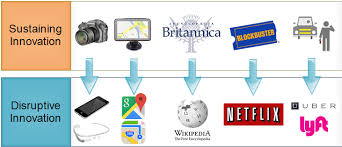The Power of Disruptive Innovation
Disruptive innovation is a term that has gained significant traction in the business world in recent years. Coined by Harvard Business School professor Clayton M. Christensen, disruptive innovation refers to the process by which a new product or service enters the market and disrupts existing industries or markets, often displacing established market leaders.
Unlike traditional incremental innovation, which focuses on making small improvements to existing products or services, disruptive innovation introduces a completely new way of doing things. It challenges the status quo and forces companies to rethink their business models in order to stay competitive.
One of the key characteristics of disruptive innovation is that it often starts at the low end of the market, targeting underserved or overlooked customer segments. By offering simpler, more affordable solutions that address the needs of these customers, disruptors can quickly gain traction and disrupt established players who may be focused on serving higher-end markets.
Disruptive innovation has the power to reshape entire industries, creating new opportunities for growth and driving significant change. Companies that embrace disruptive innovation can gain a competitive edge by being proactive rather than reactive to market shifts.
However, embracing disruptive innovation also comes with its challenges. Established companies may struggle to adapt to new technologies or business models introduced by disruptors, leading to potential disruptions in their own operations. The key lies in being agile and open to change, constantly seeking ways to innovate and evolve in response to market dynamics.
In today’s fast-paced business environment, disruptive innovation is not just a buzzword – it’s a strategic imperative for companies looking to thrive in an increasingly competitive landscape. By harnessing the power of disruptive innovation, businesses can unlock new opportunities for growth, drive transformational change, and stay ahead of the curve in an ever-evolving marketplace.
Understanding Disruptive Innovation: Key Insights and Strategies for Success
- What is disruptive innovation and how does it differ from incremental innovation?
- Can you provide examples of companies that have successfully implemented disruptive innovation?
- How can established companies adapt to disruptive innovation in their industries?
- What are the key characteristics of a disruptive innovator?
- What are the potential risks and challenges associated with embracing disruptive innovation?
- How does disruptive innovation impact market dynamics and competition?
- Are there specific industries or sectors that are more prone to disruption through innovative technologies?
- What role does leadership play in driving and sustaining disruptive innovation within an organisation?
What is disruptive innovation and how does it differ from incremental innovation?
Disruptive innovation and incremental innovation are two distinct approaches to driving change and growth within businesses. Disruptive innovation involves the introduction of a new product or service that fundamentally alters the existing market landscape, often targeting underserved customer segments with a radically different value proposition. In contrast, incremental innovation focuses on making gradual improvements to existing products or services, aiming to enhance their features or functionalities without fundamentally changing the market dynamics. While disruptive innovation can lead to significant industry disruptions and the creation of entirely new markets, incremental innovation tends to be more iterative and evolutionary in nature, aiming to sustain and improve upon existing offerings rather than revolutionise them.
Can you provide examples of companies that have successfully implemented disruptive innovation?
Certainly! Many companies have successfully implemented disruptive innovation to revolutionize their industries. One notable example is Netflix, which disrupted the traditional video rental market by introducing a subscription-based streaming service that changed how people consume entertainment. Another example is Uber, which transformed the transportation industry by offering a convenient and cost-effective alternative to traditional taxis through its ride-hailing app. These companies demonstrate how embracing disruptive innovation can lead to significant growth and market dominance in an increasingly competitive business landscape.
How can established companies adapt to disruptive innovation in their industries?
Established companies can adapt to disruptive innovation in their industries by fostering a culture of innovation and embracing change. It is crucial for these companies to stay agile and open-minded, continuously seeking opportunities to evolve their products, services, and business models in response to market shifts. By investing in research and development, collaborating with startups, and actively monitoring industry trends, established companies can identify potential disruptors early on and proactively address emerging threats. Embracing disruptive innovation requires a willingness to challenge the status quo, experiment with new ideas, and be willing to pivot quickly when necessary. Through strategic planning, a focus on customer needs, and a commitment to staying ahead of the curve, established companies can not only survive but thrive in the face of disruptive forces shaping their industries.
What are the key characteristics of a disruptive innovator?
A disruptive innovator possesses several key characteristics that set them apart in the business world. Firstly, they have a keen ability to identify underserved or overlooked customer segments and understand their unmet needs. This enables them to develop innovative solutions that cater to these specific market gaps. Secondly, disruptive innovators are not afraid to challenge the status quo and take risks by introducing new technologies or business models that may disrupt existing industries. They exhibit a strong entrepreneurial spirit, embracing change and uncertainty as opportunities for growth rather than obstacles. Additionally, disruptive innovators are agile and adaptable, continuously seeking ways to evolve and stay ahead of the curve in a rapidly changing marketplace. Overall, their combination of vision, creativity, resilience, and willingness to disrupt traditional norms define the key characteristics of a disruptive innovator.
What are the potential risks and challenges associated with embracing disruptive innovation?
Embracing disruptive innovation presents companies with potential risks and challenges that must be carefully navigated. One of the main risks is the threat of existing business models becoming obsolete as disruptive technologies or new market entrants reshape industry dynamics. Companies may also face resistance from internal stakeholders who are comfortable with the status quo and reluctant to embrace change. Additionally, there is a risk of investing resources in disruptive innovations that may not yield immediate returns or may fail to gain traction in the market. To successfully navigate these challenges, companies must foster a culture of innovation, remain agile in responding to market shifts, and strategically balance short-term stability with long-term growth opportunities.
How does disruptive innovation impact market dynamics and competition?
Disruptive innovation fundamentally alters market dynamics and competition by challenging traditional norms and reshaping industry landscapes. When disruptive technologies or business models enter the market, they often target underserved customer segments with simpler, more affordable solutions, thus creating new demand and redefining market boundaries. This can lead to the displacement of established market leaders who may be slow to adapt to the changing landscape. As a result, competition intensifies as companies strive to innovate and differentiate themselves in order to stay relevant and competitive in the face of disruptive forces. Ultimately, disruptive innovation drives market evolution, fosters creativity, and compels companies to continuously reassess their strategies in order to thrive in a dynamic and ever-changing business environment.
Are there specific industries or sectors that are more prone to disruption through innovative technologies?
Certain industries or sectors are indeed more susceptible to disruption through innovative technologies. Industries that rely heavily on traditional methods and have been slow to adopt technological advancements are particularly vulnerable to disruptive innovation. For example, sectors such as retail, transportation, healthcare, and finance are prime targets for disruption due to the potential for significant efficiency gains and improved customer experiences through innovative technologies like e-commerce platforms, autonomous vehicles, telemedicine services, and fintech solutions. Companies operating in these industries must be vigilant and proactive in embracing disruptive technologies to stay competitive and relevant in an increasingly digital world.
What role does leadership play in driving and sustaining disruptive innovation within an organisation?
Leadership plays a pivotal role in driving and sustaining disruptive innovation within an organisation. Effective leaders set the vision, create a culture of innovation, and empower their teams to think creatively and take risks. They provide the necessary resources, support, and guidance to foster a climate where disruptive ideas can flourish. Additionally, strong leadership is essential in navigating the challenges that come with implementing disruptive innovation, such as resistance to change or uncertainty about the future. Leaders who champion disruptive innovation inspire their teams to push boundaries, embrace experimentation, and adapt quickly to market shifts, ultimately positioning their organisation for long-term success in a rapidly evolving business landscape.






